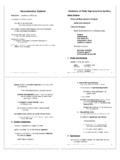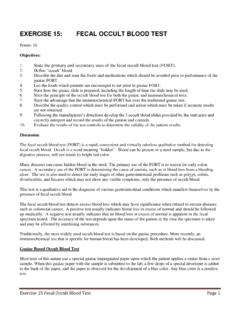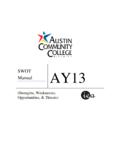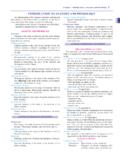Transcription of g.The Endocrine System - Austin Community College
1 Human Anatomy & Physiology: Endocrine System ; Ziser, Endocrine Systemno clear distinction between nervous and endocrinesystems=neuroendocrine systemthey are intimately interrelated! complement each other! two ends of a single spectrumThe Neuroendocrine SystemNervous SystemEndocrine Systemlocalized effects: cell to cellwidespread effects: throughout bodytargets: neurons, muscle cells or glandstargets: all organs and tissuestransmission by nerve impulsestransmission as hormone through blooduses chemical signals only cell to celluses only chemical signalsimmediate response (ms to seconds)gradual response (seconds to hours)short lived (ms to minutes)longer lived (minutes to days)Bothboth involved in coordination & controlboth produce biologically active chemicalssome parts of brain are glands/some glands are nervous tissuesome responses begin as nervous reflex and end as hormonal responsesGeneral Characteristics of Hormones1.
2 A chemical is considered a hormone if it is secretedand transported in the bloodsame chemical can also be a neurotransmitter, or lymphokine, etcthe major hormones are secreted from ductlessglands directly into bloodHuman Anatomy & Physiology: Endocrine System ; Ziser, (exocrine vs Endocrine glands)all major Endocrine glands are richly supplied with blood capillaries2. most, if not all, organs produce hormones officially the Endocrine System consists of several major glands and many minor glands3. Hormones are secreted in response to specificstimuli3 mechanisms: neural, humoral, hormonal A. Humoralhormones secreted in direct response to changingblood levels of certain chemicals in bloodaffect Endocrine gland directlyB.
3 Neuralhormones secreted due to direct nervous stimulationC. HormonalAnterior Pituitary = master glandsecretes several hormones that control the secretion of other Endocrine glands! Tropic Hormones4. Many Endocrine glands secrete more than onehormonehormones can be secreted independently of one anotherHuman Anatomy & Physiology: Endocrine System ; Ziser, hormone effects are highly specific to targetorgan ! requires specific binding site(receptor proteins)even though every hormone comes in contact with every cellreceptor can be on the surface of the target cell or inside the target celltarget cells respond only to specific hormones6. At the cellular level each hormone can affect a target cell in only a few ways:a.
4 Can change in cell membrane permeabilityeg. change in secretory activity of a cellb. can alter metabolic pathway(s)eg. enzymes activated or inactivated! make new products! cease making productc. can change rate of cell divisioneg. speed up or slow downMaybe different effects in different target cells forsame hormone7. Most cells have receptors for more than one typeof hormonehormones can interact with each otherHuman Anatomy & Physiology: Endocrine System ; Ziser, ! synergistic effects= presence of 1 enhances effects of other! antagonistic effects= 1 counteracts effects of other! permissive effects= one hormone primes target organ for anotherhormone;8. Hormones don t accumulate in bloodthose that bind to target cells are destroyed!
5 Half-life ~ seconds 30 minutesexcess are continually cleared by liver and kidneytherefore for prolonged effect! hormones must be continuously secretedHuman Anatomy & Physiology: Endocrine System ; Ziser, Endocrine GlandsPituitary Gland (=Hypophysis)small but extremely important structureattached to a stalk (infindibulum) at base ofhypothalamushoused in sella turcica of sphenoid boneconsists of two separate glandsAnterior Pituitary Glandmaster glandsecretes tropic (or trophic) hormones:a. Thyroid Stimulating Hormone (TSH)! stim development and secretions fromthyroid glandb. Adrenocorticotropic Hormone (ACTH)! normal growth and development of adrenalcortexc. Follicle Stimulating Hormone (FSH)Human Anatomy & Physiology: Endocrine System ; Ziser, !
6 In women: stimulates follicles to begingrowing to ovulation! in men: stimulates development ofseminiferous tubules and sperm cellsd. Leutinizing Hormone (LH)! in women:final maturation of folliclestimulates formation of corpus luteum[a temorary Endocrine gland of pregnancy]promotes secretion of progesterone! in men:stimulates interstitial cells to secretehormone = testosteroneif pituitary gland is removed by radiation or surgery, needhormone treatment rest of life or some other glands willshut downin addition to tropic hormones, Ant Pit also secretessome other (nontropic) hormones:e. Growth Hormone (GH)promotes growth of bone and soft tissueHuman Anatomy & Physiology: Endocrine System ; Ziser, ! stim protein synthesisamt of GH secreted decreases with age HYPERSECRETION of GHduring childhood !
7 Gigantismduring adulthood ! acromegalyenlargement esp of bones of hands, feet, jaws and cheeks HYPOSECRETION of GH during childhood! dwarfismf. Prolactin (PRL; = Lactogenic Hormone)affects female:! induces breast development duringpregnancy! initiates milk secretion after childbirthprl release is stimulated by sucklingno significant functions in malesHuman Anatomy & Physiology: Endocrine System ; Ziser, Pituitary Glandhormones released by direct nervous stimulation of posterior pituitarya. Antidiuretic Hormone (ADH, =vasopressin)(=against production of urea)ADH is released whenever receptors indicateddehydrationie. decreases urine outputconserves waterb. Oxytocin(=swift childbirth)stimulates contraction of uterine muscles during laborcauses milk ejection into ducts as result of nursing infant [let down reflex]triggered by neural stimulus: sucklingfunctions in societal memory : affects ability to recognize & trust others[deficiency may be correlated with autism]Human Anatomy & Physiology: Endocrine System ; Ziser, Glandlocated behind the midbrain and 3rd ventricleattached to roof of third ventriclenot sure of all its functions in humans but seems to regulate cyclic activitiesRene Descartes (1596-1650) thought it was the seat ofthe human soulis light sensitive !
8 Monitors photoperioda. Melatoninmain hormone it secretes is melatoninlight suppresses productiondark stimulates production!secretion rises at night, fluctuates seasonallyand with changing day lengthin lower animals it helps regulate cyclic activities:hibernationestrousmigrationIn humans:! may help regulate menstrual cycle! inhibits onset of puberty in malesmay be related to seasonal affective disorder andPMSH uman Anatomy & Physiology: Endocrine System ; Ziser, temporary Endocrine glandbehind sternum, below thyroidlarge in fetus and childmaximum size at pubertydegenerates in adult (replaced with fat)functions as Endocrine gland and as part of immunesystemsecretes thymosin and related hormones! stimulates development of lymphatic organs!
9 Induces maturation and development of WBC sparticularly T-lymphocytesHuman Anatomy & Physiology: Endocrine System ; Ziser, Glandthe largest Endocrine gland in adultssurrounds trachea just below larynxconsists of 2 lobes !usually described as butterfly shapedHormones:a. Thyroid Hormones (T3, T4)activated by TSH from Ant Pitcontain Iodine atoms98% of body s Iodine is in the thyroid glandinadequate iodine in diet ! goiterthyroid hormones help to regulate metabolismin all cells:! increases metabolic rate & ATP production! increase oxygen consumption and bld O2 levels! promotes maturation and development of thenervous System ! increases protein synthesis!help maintain normal reproductive functionmany environmental stimuli can inhibitsecretions of this gland:cold temp, physical stressors, noxious stimuliHuman Anatomy & Physiology: Endocrine System ; Ziser, of Thyroid Hormones!
10 Graves diseaseup to 30% increase in Metabolic Rate! appetiteweight lossnervous irritabilityHYPOSECRETION of Thyroid HormonesDuring growing years! cretinismlow metabolic rateretarded growth and sexual develoften mentally retardedAs adult! Myxedemaloss of mental and physical vigorweight gainthickened skinb. Calcitonindecreases blood Ca++ / promote bonedeposition byinhibiting osteoclastsstimulating osteoblastsits effects are significant only in children,negligable effect in adultsHYPOSECRETION of Calcitonincan cause ricketts in children (but usually due to Ca+ + or Vit D deficiency)Human Anatomy & Physiology: Endocrine System ; Ziser, Glandssmall round bodies attached to the posterior surfacesof the thyroid glandusually 4 or 5, but variesa.













